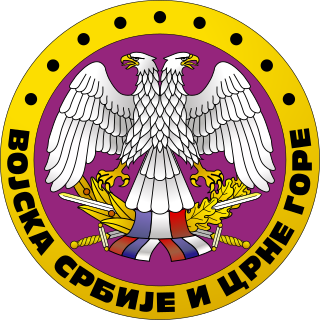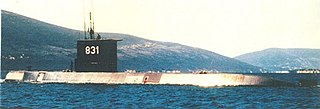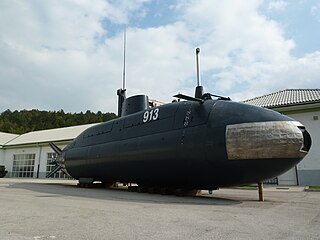
The Armed Forces of Serbia and Montenegro included ground forces with internal and border troops, naval forces, air and air defense forces, and civil defense. Preceding the VSCG was the Yugoslav Army from the remnants of the Yugoslav People's Army (JNA), the military of SFR Yugoslavia. The state, then named Federal Republic of Yugoslavia, participated in the Yugoslav Wars with limited direct intervention of its own armed forces. Following the end of the Wars and the constitutional reforms of 2003 by which the state was renamed "Serbia and Montenegro", the military accordingly changed its name. The military was heavily involved in combating Albanian separatists during the Kosovo War and Preševo Valley conflict, and also engaged NATO airplanes during the 1999 NATO bombing of Yugoslavia.

A frogman is someone who is trained in scuba diving or swimming underwater in a tactical capacity that includes military, and in some European countries, police work. Such personnel are also known by the more formal names of combat diver, combatant diver, or combat swimmer. The word frogman first arose in the stage name The Fearless Frogman of Paul Boyton in the 1870s and later was claimed by John Spence, an enlisted member of the U.S. Navy and member of the OSS Maritime Unit, to have been applied to him while he was training in a green waterproof suit.

A dry deck shelter (DDS) is a removable module that can be attached to a submarine to allow divers easy exit and entrance while the boat is submerged. The host submarine must be specially modified to accommodate the DDS, with the appropriate mating hatch configuration, electrical connections, and piping for ventilation, divers' air, and draining water. The DDS can be used to deploy a SEAL Delivery Vehicle submersible, Navy divers, or Combat Rubber Raiding Craft (CRRC).

A diver propulsion vehicle (DPV), also known as an underwater propulsion vehicle, sea scooter, underwater scooter, or swimmer delivery vehicle (SDV) by armed forces, is an item of diving equipment used by scuba divers to increase range underwater. Range is restricted by the amount of breathing gas that can be carried, the rate at which that breathing gas is consumed, and the battery power of the DPV. Time limits imposed on the diver by decompression requirements may also limit safe range in practice. DPVs have recreational, scientific and military applications.

A midget submarine is any submarine under 150 tons, typically operated by a crew of one or two but sometimes up to six or nine, with little or no on-board living accommodation. They normally work with mother ships, from which they are launched and recovered and which provide living accommodation for the crew and support staff.

The SEAL Delivery Vehicle (SDV) is a crewed submersible and a type of swimmer delivery vehicle used to deliver United States Navy SEALs and their equipment for special operations missions. It is also operated by the Royal Navy's Special Boat Service, which operates three SDVs.

Human torpedoes or manned torpedoes are a type of diver propulsion vehicle on which the diver rides, generally in a seated position behind a fairing. They were used as secret naval weapons in World War II. The basic concept is still in use.

The Croatian Navy is a branch of the Croatian Armed Forces. It was formed in 1991 from what Croatian forces managed to capture from the Yugoslav Navy during the breakup of Yugoslavia and Croatian War of Independence. In addition to mobile coastal missile launchers, today it operates 30 vessels, divided into the Navy Flotilla for traditional naval duties, and the Croatian Coast Guard. Five missile boats form Croatian fleet's main offensive capability.

The Yugoslav Navy, was the navy of Yugoslavia from 1945 to 1992. It was essentially a coastal defense force with the mission of preventing enemy landings along Yugoslavia's rugged 4,000-kilometer shoreline or coastal islands, and contesting an enemy blockade or control of the strategic Strait of Otranto.

A wet sub is a type of underwater vehicle, either a submarine or a submersible, that does not provide a dry environment for its occupants. It is also described as an underwater vehicle where occupants are exposed to ambient environment during operations. The watercraft is classified as medium-sized or small vessel. This type of submarine differs from other underwater personal transport devices by the fact that it has a hull around it and it is not a "bare bones" design.

Brodosplit is the largest shipyard in Croatia, located in the Supaval bay, on the north side of the Split peninsula.

The Beograd class of destroyers consisted of three ships built for the Yugoslav Royal Navy in the late 1930s, a variant of the French Bourrasque class. Beograd was constructed in France and Zagreb and Ljubljana were built in the Kingdom of Yugoslavia. In January 1940, Ljubljana struck a reef off the port of Šibenik, and was still under repair when the German-led Axis invasion of Yugoslavia commenced in April 1941. During the invasion, Zagreb was scuttled to prevent its capture, and the other two ships were captured by the Italians. The Royal Italian Navy operated Beograd and Ljubljana as convoy escorts between Italy, the Aegean Sea, and North Africa, under the names Sebenico and Lubiana respectively. Lubiana was lost in the Gulf of Tunis in April 1943; Sebenico was seized by the Germans in September 1943 after the Italian surrender and was subsequently operated by the German Navy as TA43. There are conflicting reports about the fate of TA43, but it was lost in the final weeks of the war.
Naval Special Warfare Group 3 (NSWG-3), based at the Naval Amphibious Base Coronado in California, was one of six constituent formations of the United States Naval Special Warfare Command. Until 2008, NSWG-3 was composed of two SEAL Delivery Vehicle Teams: SDVT-1 in Pearl Harbor and SDVT-2 in Little Creek. In 2008, SDVT-2 was disestablished and merged into SDVT-1, which was then now headquartered in Pearl Harbor and operated detachments in Pearl Harbor and Little Creek. SDV Teams are SEAL teams with an added underwater delivery capability. SDVT-2 was reactivated on 8 March 2019. NSWG-3 was deactivated alongside NSWG-10 in August 2021 and replaced by Naval Special Warfare Group 8 which took in all units previously under NSWG-3 and NSWG-10.

The Heroj class was a class of diesel-electric attack submarines built for the Yugoslav Navy during the 1960s. The three strong class was the second generation of domestically built submarines, representing a significant improvement compared to the earlier Sutjeska class. Built at the Brodogradilište specijalnih objekata in Split, the new class featured a streamlined hull design and four bow facing torpedo tubes that could also be used for minelaying.

The Sava class was a class of diesel-electric attack submarines built for the Yugoslav Navy during the late 1970s and early 1980s. Developed by the Brodarski Institute (BI) from Zagreb, the two strong class was built by the Brodogradilište specijalnih objekata in Split. They were intended as a replacement for the aging Sutjeska-class submarines. Compared to the earlier Heroj class, the Sava class was longer with more powerful armament that consisted of six torpedo tubes that could also be used for minelaying.

The Končar class is a class of six missile boats built for the Yugoslav Navy during the late 1970s at Tito's Shipyard Kraljevica, SR Croatia. The boats featured a mixture of Western and Eastern European equipment, including Soviet anti-ship missiles and Swedish guns.

The Una-class submarine was a class of six midget submarines built for the Yugoslav Navy at the Brodogradilište specijalnih objekata during the 1980s. They were designed with the purpose of laying small minefields and transporting naval special forces, with or without their submersibles, in shallow waters that were inaccessible for larger submarines. Due to their mission profile that called for a small design as well as the need to stay undetected, they lacked torpedo armament and a generator for battery recharging.

Velebit was a modified Una-class midget submarine and the only submarine to see service with the Croatian Navy. It was built for the Yugoslav Navy during the 1980s where it was named Soča. At the outbreak of the Croatian War of Independence Soča was being overhauled in the Brodogradilište specijalnih objekata division of Brodosplit shipyard in Split, Croatia. Although stripped of all equipment, it was preserved from the retreating Yugoslav forces by the shipyard workers.

The Silba class is a class of three landing ships, also used as minelayers, built for the Yugoslav (JRM) and Croatian Navy (HRM) during the 1980s and 1990s. The ships were built at the Brodogradilište specijalnih objekata shipyard in Split with slight differences in armament configuration between the last two ships. By the time the Croatian War of Independence started, one ship was in service with the JRM while another was being completed.



















